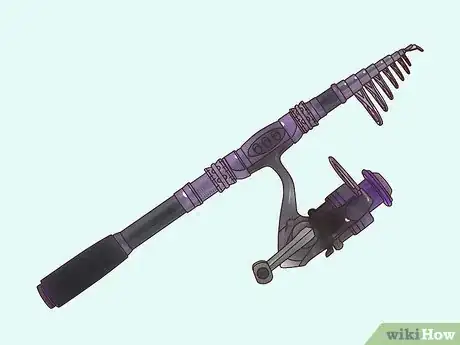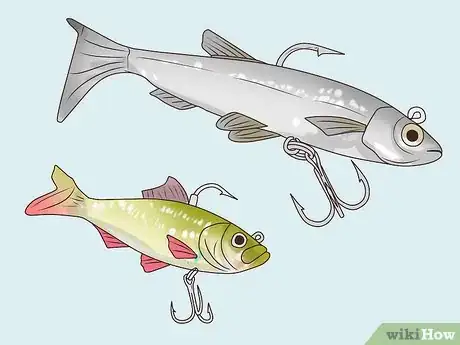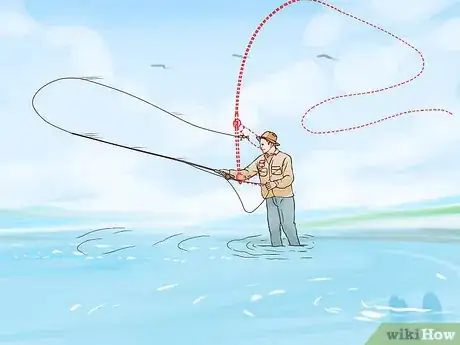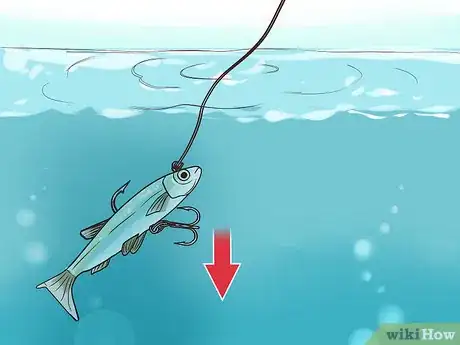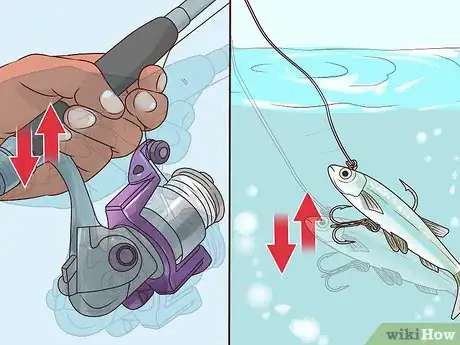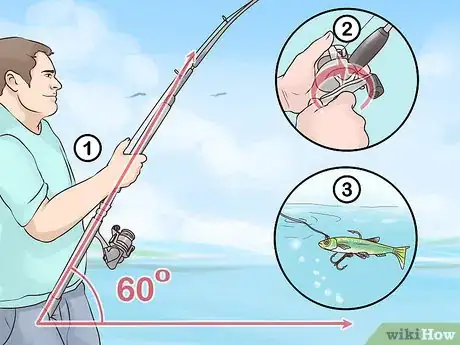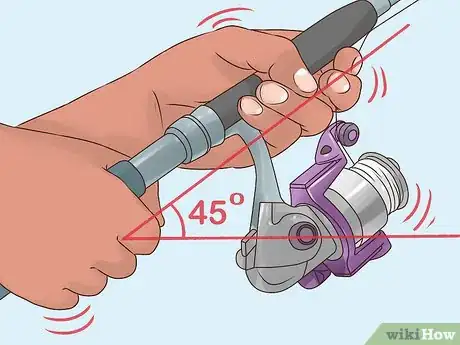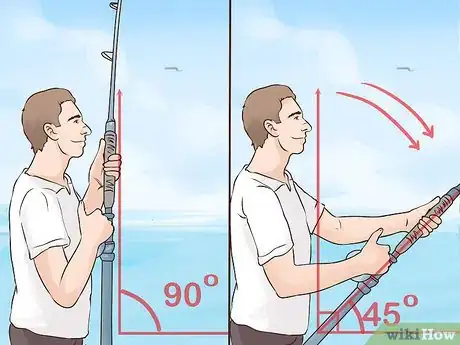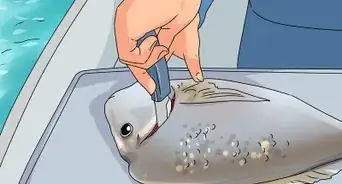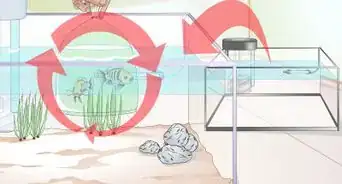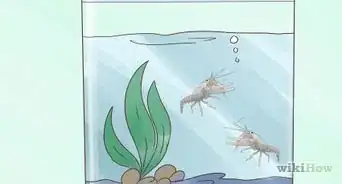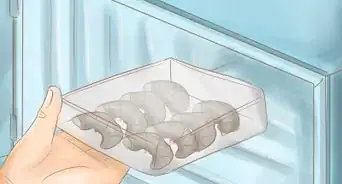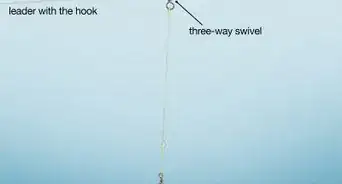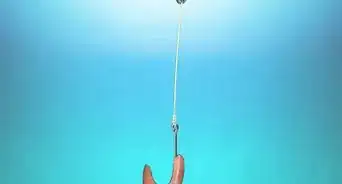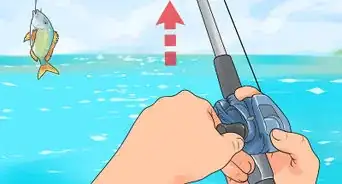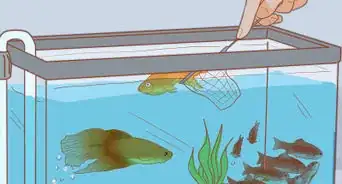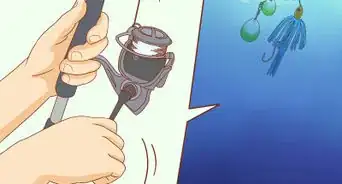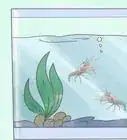This article was co-authored by wikiHow Staff. Our trained team of editors and researchers validate articles for accuracy and comprehensiveness. wikiHow's Content Management Team carefully monitors the work from our editorial staff to ensure that each article is backed by trusted research and meets our high quality standards.
There are 7 references cited in this article, which can be found at the bottom of the page.
This article has been viewed 76,196 times.
Learn more...
Jig fishing is a sport that uses jig bait hooks, which mimic prey for large fish. Jig fishing should be done in some kind of heavy cover, where large fish usually hide to wait for their next meal, and not in open water. Be sure to use a heavy-duty rod, strong fishing line, and a good choice of jigs to catch fish.[1]
Steps
Choosing Your Equipment
-
1Buy a heavy-duty fishing rod. For jig fishing, purchase a heavy action or extra-heavy action rod. A stronger rod will handle large fish better and hold up if your line gets caught in the heavy cover (e.g. seaweed) that they often hide in. Shop for a fishing rod at your local sporting goods store to properly gauge the feel and sturdiness of different models. [2]
-
2Use a sturdy fishing line. Purchase a heavy braided fishing line of 50 pounds (23 kg) or more for jig fishing to avoid breaking. Heavier lines will not stretch, allowing you to pull in bigger fish more efficiently. A sturdier line will also stand up to thick cover like heavy vegetation and be easier to free if it gets stuck.[3]Advertisement
-
3Choose realistic-looking jigs. If possible, try to use jigs that resemble the prey of the fish you are trying to catch (e.g. smaller fish local to the body of water). Jigs come in a variety of shapes, sizes, and colors. To start, buy an assortment of jigs to experiment with, and to use in different water temperatures and with different types of cover.[4]
Using Jigs
-
1Set up your fishing rod. Hold the fishing rod with your casting hand at the base of the reel. Leave about 12 inches (30 cm) of line hanging between your bait hook and the tip of the rod. Grab the line with your index finger and keep it taut.[5]
-
2Cast out your line. Make sure that there is nothing behind you for the line to catch onto (e.g., a tree or other person). Aim the line at the line towards the spot in the water you want it to land in, then pull it backwards. Cast it out and release your index finger from the line.[6]
-
3Wait for your jig hook to hit the bottom of the body of water. After casting your rod, wait several seconds for the jig hook to reach the bottom. If the bait is heavy enough you may feel the spoon hit the bottom. Note that lightweight jig hooks will take longer to sink.[7]
-
4Snap and pop the line. Make boisterous vertical motions with your rod by flicking your wrist and popping your fishing rod tip up a short distance. Allow the jig hook to sink back to the bottom. Repeat this process to get the attention of larger fish looking for food.[8]
- Vary your movements by jigging the rod up and down and side-to-side.
-
5Use the “swimming” technique. Cast your line out into the water. Hold your fishing rod at a 60 degree angle and slowly reel the line in. This motion will cause the jig to flow through the water smoothly, appearing to swim.[9]
Reeling in a Catch
-
1Pay close attention to your line. Be sure to keep a close eye on your fishing line while it is in the water. When you have a bite, your line will usually jolt at the surface of the water. Watch for this sort of movement, as it may not be jarring enough for you to feel it all the way through your line and fishing rod.[10]
-
2Hold onto the rod tightly. Big fish will put a lot of pressure on the line as they try to swim away. Once a fish has gone for your bait, lower your fishing rod to a 45 degree angle and hold on tightly. Stay in this position until the fish stops pulling on the line.[11]
-
3Engage your reel to pull in the fish. Holding the line steady, pull the fishing rod upwards as if you want to form a 90-degree angle. Lower the rod back to a 45-degree angle, engage your reel and begin to pull in your catch. Repeat this raising/lowering/and reeling-in pattern until you bring in your catch.[12]
Community Q&A
-
QuestionCan I jig fish in creeks/rivers? If not, what types of baits are the best to use in creeks?
 614 FishingCommunity AnswerJig fishing can be effective in any type of water. If the creek is rocky, consider using a soft plastic craw as a trailer.
614 FishingCommunity AnswerJig fishing can be effective in any type of water. If the creek is rocky, consider using a soft plastic craw as a trailer.
References
- ↑ http://bassdozer.com/articles/jig-fishing.shtml
- ↑ http://www.gameandfishmag.com/fishing-tips-and-tactics/4-tips-when-jig-fishing-for-bass/
- ↑ http://www.gameandfishmag.com/fishing-tips-and-tactics/4-tips-when-jig-fishing-for-bass/
- ↑ https://www.bassresource.com/fish/jigs.html
- ↑ http://www.popularmechanics.com/adventure/outdoors/a12982/the-secrets-of-the-perfect-cast-16988251/
- ↑ http://www.popularmechanics.com/adventure/outdoors/a12982/the-secrets-of-the-perfect-cast-16988251/
- ↑ https://www.takemefishing.org/how-to-fish/fishing-with-lures/jigging/
- ↑ https://www.takemefishing.org/how-to-fish/fishing-with-lures/jigging/
- ↑ https://www.bassresource.com/fish/jigs.html
About This Article
Jig fishing is a type of sport that uses jig bait hooks to mimic prey for large fish. First, choose a spot with heavy cover to go jig fishing, as this is where large fish are likely to hide. Cast out your line by aiming towards the spot you want to fish in and then pulling the line backward. Wait several seconds for the jig hook to hit the bottom. Once the jig hook has hit the bottom, snap and pop the line to get the attention of large fish that are looking for food. When you have a bite, lower the rod to a 45-degree angle and hold on tightly, as large fish will put a lot of pressure on the line. To pull the fish in, raise the rod up, then lower it down and engage the reel. For more information on doing jig fishing, like how to choose a realistic-looking jig, read on!
